Question Types
There are many different question types in Rogo, and different settings which don’t apply to all question types. Before adding options you would need to save the question, the only required fields to save a question are the Question Name and the Question Type.
Please note for all multile coice questions
Radio Button
A multiple-choice question which accepts only 1 answer. Good for 2-8 options, depending on how many questions you have on one screen, for more options see Drop Down below. A Radio Button can be displayed either vertically or horizontally. You can also use negative scoring for incorrectly selected options. This question will be auto-marked by the system.

Once you have given your question a name you can save it and add your options at the bottom of the page, then add marks to the correct option. 
*You can randomise the order of the answer options in Radio Button, Checkbox and Dropdown question types. Please email support@eintech.com to switch this feature on.
Hidden Calculation Only Radio Button Question
You can create a radio button question which only includes calculations that are hidden from the student so that additional marks can be awarded. This has been created to add to our current AAT functionality and can be used for their new question.
This question is not automatically available and will need to be switched on for individual instances of Rogo.
This feature can be used in auto-marked cases where a student’s response can be given in any order, however specific responses are worth different marks:

For the above example you can award 1 mark to each of the text boxes, if the response in the text box and corresponding drop down are correct, and then create two radio button questions to award the additional marks.
The calculations in the radio button questions would be similar to the following:


The student however would only view the drop down and text box questions and not the radio buttons and would still be able to gain a total of 5 marks for the question.
This feature is not automatically available and will need to be switched on for individual instances of Rogo.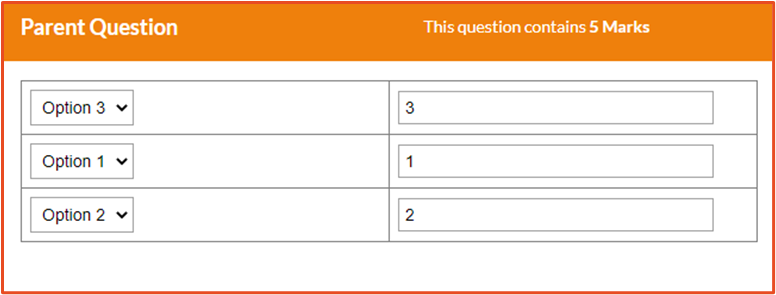
Check Box
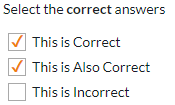 Multiple-choice question which accepts 1 or more selections, this is good for questions which require you to select more than one option, e.g. Which of the following… type questions. You can also use negative scoring for incorrectly selected options. This question will be auto-marked by the system.
Multiple-choice question which accepts 1 or more selections, this is good for questions which require you to select more than one option, e.g. Which of the following… type questions. You can also use negative scoring for incorrectly selected options. This question will be auto-marked by the system.
A check box question is set up in exactly the same way as a radio button, however can have multiple correct options, you can also set a maximum number of selections to the question, preventing people from selecting more options than they should.

*You can randomise the order of the answer options in Radio Button, Checkbox and Dropdown question types. Please email support@eintech.com to switch this feature on.
Drop Down
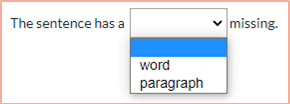 A Multiple-choice question which accepts 1 answer. This will generally be used instead of a Radio Button if there are a lot of options, or space is limited. This question type can also be used in a custom layout to fill in a space in a sentence. This question will be auto-marked by the system.
A Multiple-choice question which accepts 1 answer. This will generally be used instead of a Radio Button if there are a lot of options, or space is limited. This question type can also be used in a custom layout to fill in a space in a sentence. This question will be auto-marked by the system.
Drop down questions are set up in the same way as a radio button, to place the drop down within a sentence like in the image above see the section on custom layout.
*You can randomise the order of the answer options in Radio Button, Checkbox and Dropdown question types. Please email support@eintech.com to switch this feature on.
Text Box
Good for short answers, single words or numerical inputs. You can set a validation on this question e.g. currency or number formatting, the system will then format the student’s answer as such and if it cannot (unrecognised format) it will display an error informing the student, for more information on this see the validation section. 
You can also set the option to a calculation instead of a standard option, this allows Rogo to award marks on a question even if one of the students previous responses which feeds into this question was answered incorrectly, for more information on this, see the calculations section. This question is auto-marked by the system.
Text Area
Text Area questions are good for long text responses. If there is a word limit you can also enable word count to help the student to stick to this. You can choose for students to view this question type with or without formatting controls such as Bold/Headings/Font Colour etc.

This type of question cannot however be marked by the system and will need to be human marked.
File Upload
The question type will display a file selector so the student can upload files from their local computer. This can be used for e-portfolios or if external software is required, they can upload an export to be manually marked by an examiner. The student will save their answers on their computers and then upload them back onto the test simulation. This type of input cannot be marked by the system and will need to be human marked.
Date Picker Question Type
The date picker question type helps to support an AAT question style, it allows a student to choose a date from a calendar modal.
This feature is not automatically available and will need to be switched on for individual instances of Rogo, if this is functionality you are interested in using, please contact support@eintech.com for further details.
When creating a date picker question type, the question author will also use the calendar to choose the correct option. As with other question types, multiple correct options can be provided. Clicking on the Month/Year at the top of the modal will take you out one level on the calendar and allow you to easily select another month/year. 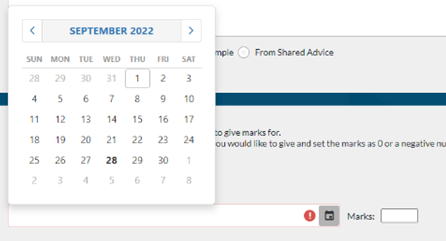
Hotspot
Allows the student to select a point on an image. The image can be a graph/chart or a photograph of a room and the student is asked to identify an object or hazard etc. This can be auto marked, and you can set different areas on the image to be worth different marks, however, students can only make one selection.
When creating a Hotspot question you will begin by uploading an image to the question, once done you can add your marks. Enter a mark in the ‘marks’ box and then click on Draw, this will bring up a small pop-up with your image in it, on which you can select the area of the image which will award marks. Make sure you click on Save after you have selected the correct area and then click on Add to add the marks to the question.
Ranking
An intuitive way for your students to order or prioritise statements. The options are randomised when first displayed, the student then drags them into the correct order within the box. With this type of question, you can ask the student to identify priorities, process flows, weighting, and other ordering questions.
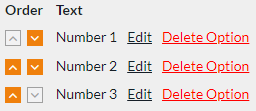
When creating this question, you should input your options in the correct order, the system will then present them to the student at random. This question will be auto-marked by the system.
Drag And Drop
The same intuitive dragging method as Ranking, but with different options or categories.
You can use this type of question for simple drag and drop, more complex ranking or categorisation questions, gap fill and more. This question will be auto-marked by the system.
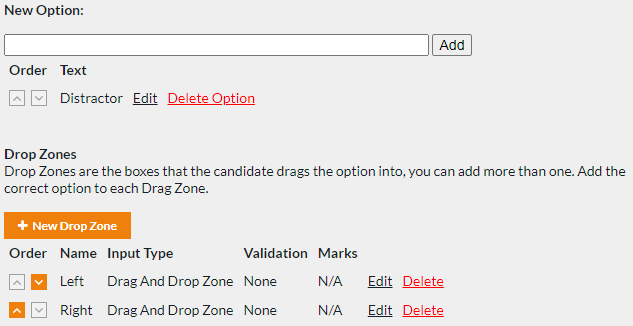 When creating a Drag and Drop question, you will begin by creating the drop zones, the areas in which students need to drag the responses to, once you have created your drop zone you will need to add options to the drop zone. The options added to the drop zone would be the correct answers, you can also add additional distractor options to the main question.
When creating a Drag and Drop question, you will begin by creating the drop zones, the areas in which students need to drag the responses to, once you have created your drop zone you will need to add options to the drop zone. The options added to the drop zone would be the correct answers, you can also add additional distractor options to the main question. 
Spreadsheet Advanced
The Spreadsheet Advanced question type is an advanced spreadsheet emulator which provides additional functionality and enhanced usability for the student, and more closely replicates a real-world experience. This question type is set up in the same way as the spreadsheet question. This question will need to be human-marked.
When creating a Spreadsheet question you will need to add a Sub-Question to add the marks. There are two possible Sub-Questions which can be created, Drop Down or Text Box, if the Sub-Question created is a Drop Down then the marker will either be able to award zero or the maximum number of marks, whereas with a Text Box question the marker can award any mark up to the maximum. Choose the question type and then save it before adding the marks.
Sub-Questions in a Spreadsheet Advanced question also have the option to add Marking Advice, this will then be shown to the marker in the script but not shared with the student. You can also add feedback to the Sub-Question which you can share with students if the exercise settings allow this.
You can also upload templates for spreadsheet question featuring elements such as pre-populated tables and data, allowing you to offer questions that require students to fill in part of a spreadsheet or leave it blank.
This feature is not automatically available and will need to be switched on for individual instances of Rogo, if this is functionality you are interested in using, please contact support@eintech.com for further details.
Matrix
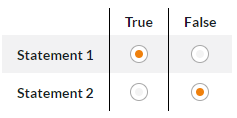 Also known as a Rating or Scale question, these are very helpful for allocating a list of items to a category, marking multiple statements as True or False, or simply a different layout for a standard single radio button list. This question will be auto-marked by the system.
Also known as a Rating or Scale question, these are very helpful for allocating a list of items to a category, marking multiple statements as True or False, or simply a different layout for a standard single radio button list. This question will be auto-marked by the system.
When setting up a Matrix question you will need to begin by adding the column headings to the question, you can then begin setting up the Matrix rows. You won’t be able to add additional columns once you begin adding rows, so make sure you have these all done first. Once you have saved your row you will then be able to assign a mark to the correct column for that row.
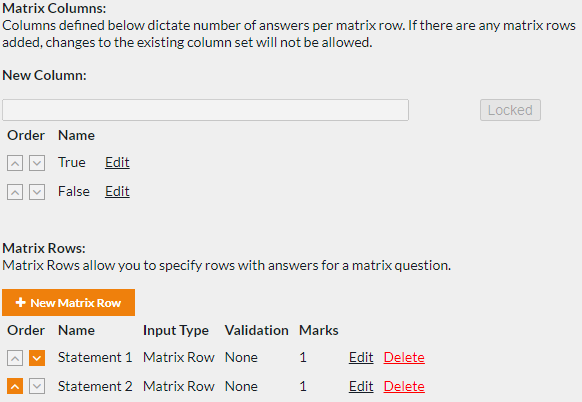
Check Box Matrix
A Check Box Matrix question is similar to a matrix question, however you can select multiple options in each row. This question will be auto-marked by the system.

This question type will be set up in the same way as the matrix question, by first adding the column headings to the question, then setting up the Matrix rows. However this time you will be able to set multiple columns as being correct for each row.
Radio Button Table
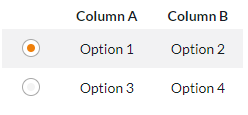 A more complex Radio Button List, allowing you to show tabular data and have the student select the correct option. This question will be auto-marked by the system.
A more complex Radio Button List, allowing you to show tabular data and have the student select the correct option. This question will be auto-marked by the system.
When setting up a Radio Button Table you will once again begin by creating your columns, once you have your columns set up you can then add an option for each row you want to include in the table.
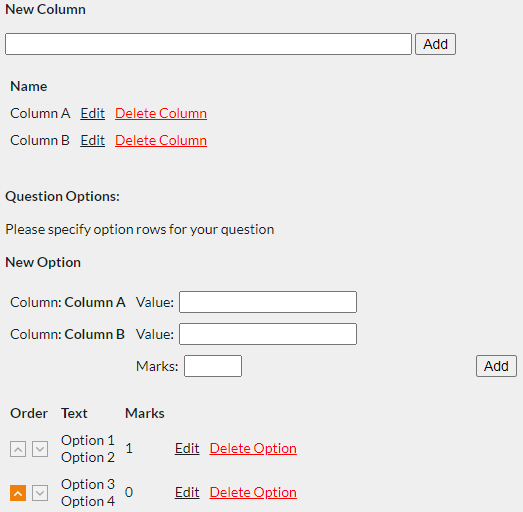
Check Box Table
Similar to a Radio button table, but with the ability to select more than 1 row. This question will be auto-marked by the system.
A Check Box Table will be set up in exactly the same way as the Radio Button Table above, in this case however students can select multiple options so you can have multiple correct answers.
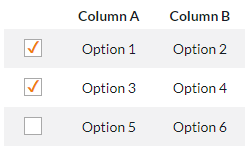
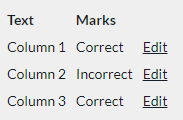
Workspace
A workspace question allows a student to emulate a workspace, giving them access to a spreadsheet, text area and slides to answer a complex question in different ways as they would be able to in a workspace. This question type is also the only way to have both a Text Area and Spreadsheet as part of the same question. This question will need to be human marked.
When creating a Workspace, you will need to add your response options to the question. The marks for this question will be added to the main question and not to the response options.

Essay
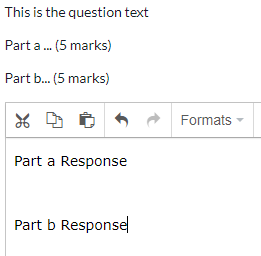 The ‘Essay’ question allows you to have separate scoring for different parts of the question, while only providing the student one Text Area in which to respond. This question is set up similarly to a Spreadsheet Question where you can create Sub-Questions with different marks available.
The ‘Essay’ question allows you to have separate scoring for different parts of the question, while only providing the student one Text Area in which to respond. This question is set up similarly to a Spreadsheet Question where you can create Sub-Questions with different marks available.
Once the question type has been changed to ‘Essay’ and the question has been saved, you will then be able to add Sub-Questions. 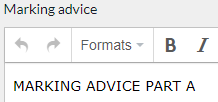

Sub-Questions in an Essay Question also have the option to add Marking Advice, this will then be shown to the marker in the script but not shared with the student. You can also add feedback to the Sub-Question which you can share with students if the exercise settings allow this.
Parent Question
This allows you to create complex questions, or multi-part questions, for example, a data table that requires the student to enter figures on multiple rows. Only two question types, Spreadsheet and Workspace, cannot be used as sub-questions in a Parent question.
You can also use this to group questions together and require that all parts are correct to score any points. Depending on the sub-questions used a Parent question could be either auto-marked, human marked or use a combination of the two.
Once you have set a question as a Parent question you can then add as many sub-questions as you would like.
